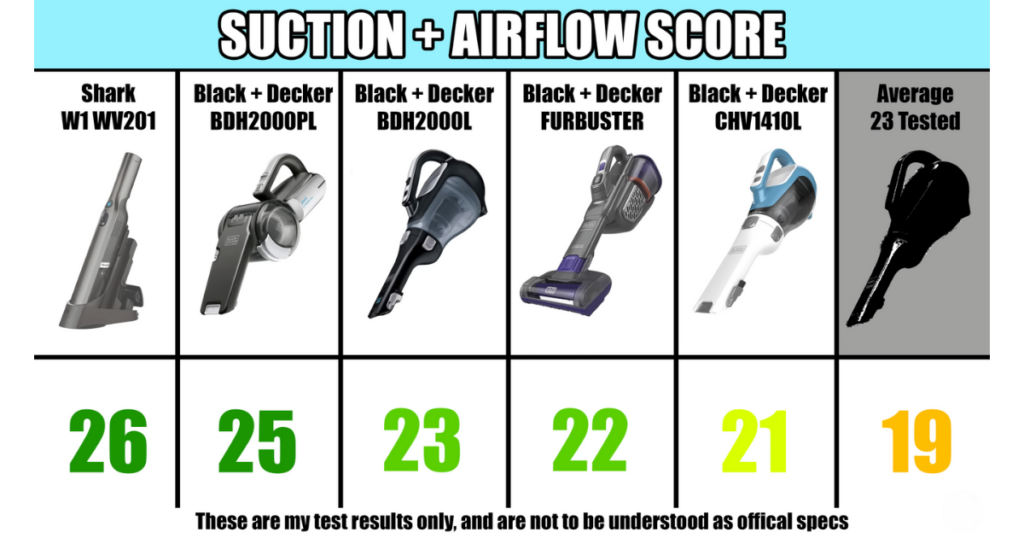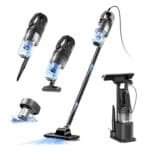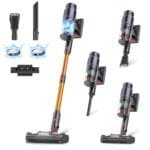Ever wondered how vacuum cleaners suck up dirt so effectively? The secret lies in their suction power.
Understanding vacuum suction power can seem complex, but it’s simpler than you think. At its core, it involves creating a pressure difference that pulls in air and debris. This principle is the same in both small handheld models and large industrial machines.
By learning how suction power works, you can make better choices when buying a vacuum. Also, you can troubleshoot issues more effectively. Dive into the mechanics of vacuum suction, and you’ll see how this simple concept results in a cleaner home. Ready to learn more? Let’s get started!

Credit: www.cnet.com
Introduction To Vacuum Suction
Vacuum suction is a fascinating concept. It plays a vital role in our daily lives. From cleaning our homes to complex industrial tasks, its applications are vast. Understanding how it works helps us appreciate its importance.
Vacuum suction operates on a simple principle. It creates a difference in pressure. This pressure difference pulls in air and particles. The vacuum cleaner’s motor creates this pressure difference. As the motor runs, it generates suction power. This power is what allows the vacuum to clean surfaces effectively.
Importance Of Suction Power
Suction power determines a vacuum’s efficiency. Strong suction power means better cleaning. It helps remove dirt, dust, and debris. Weak suction power leaves particles behind. This can lead to poor cleaning results. Choosing a vacuum with good suction power is essential.
Applications Of Vacuum Suction
Vacuum suction has many uses. In homes, it helps keep carpets and floors clean. In industries, it aids in material handling. It also finds use in medical devices. Vacuum suction is crucial in various fields. Its versatility makes it indispensable.

Credit: www.amazon.com
Basic Principles Of Suction
Vacuum cleaners are essential tools in our daily lives, but have you ever wondered how their suction power actually works? Understanding the basic principles of suction can help you choose the right vacuum cleaner and use it more effectively. Let’s dive into the fascinating world of air pressure and atmospheric pressure.
Understanding Air Pressure
Air pressure plays a crucial role in vacuum suction. When you turn on a vacuum cleaner, it creates a low-pressure area inside. This low-pressure area is significantly lower than the air pressure outside the vacuum.
This difference in pressure causes the air to rush into the vacuum cleaner. As the air flows in, it carries dust, dirt, and debris along with it. Imagine opening a soda can; the rush of air you feel is similar to how a vacuum cleaner draws in particles.
Have you ever noticed how strong the suction feels when you place your hand near the vacuum hose? That’s the result of the air pressure difference. It’s this simple yet powerful principle that makes vacuum cleaners so effective.
Role Of Atmospheric Pressure
Atmospheric pressure is the force exerted by the weight of the air around us. When a vacuum cleaner operates, it relies on atmospheric pressure to create suction. The motor inside the vacuum works to reduce the pressure inside the device.
This reduction in internal pressure allows atmospheric pressure to push air into the vacuum cleaner. The stronger the atmospheric pressure, the more efficient the suction will be. Think of it like a straw in a glass of water; when you suck on the straw, atmospheric pressure pushes the liquid up.
Ever tried using a vacuum cleaner at high altitudes? You might find it less effective due to lower atmospheric pressure. This illustrates how crucial atmospheric pressure is for optimal vacuum suction.
Next time you use your vacuum cleaner, take a moment to appreciate the science behind its suction power. Understanding air pressure and atmospheric pressure can help you troubleshoot issues and make informed decisions about your cleaning tools.
What other everyday devices use similar principles to operate effectively?
Components Of A Vacuum Cleaner
Understanding the components of a vacuum cleaner helps you appreciate its functionality. The vacuum cleaner relies on several key parts to create suction. This section dives into the core components, offering a clear picture of their roles.
Motor And Fan
The motor is the heart of the vacuum cleaner. It powers the fan. The fan creates the suction force needed. As the motor runs, the fan spins rapidly. This spinning generates airflow. The airflow moves dust and debris into the vacuum. Without a working motor and fan, the vacuum cannot function.
Dust Collection System
The dust collection system traps the dirt. It ensures your space remains clean. This system includes bags or bins. The airflow carries the dust into these containers. Filters often help in this process. They stop fine particles from escaping. Regularly emptying the dust container is essential. It keeps the vacuum running efficiently.
How Suction Is Created
Understanding how suction is created in a vacuum cleaner can seem complex. But breaking it down helps simplify the process. Suction power is what makes your vacuum cleaner effective. It all starts with the basic principles of physics.
Airflow Mechanics
Airflow mechanics play a crucial role in creating suction. The motor inside the vacuum cleaner spins a fan. This spinning fan generates a flow of air. The air moves from the cleaner’s nozzle, through the hose, and into the vacuum bag or bin.
As the fan spins, it pushes air out of the vacuum cleaner. This creates a lower pressure area inside the cleaner. Higher pressure air from outside rushes in to fill the space. This movement of air carries dust and debris into the vacuum.
Pressure Differentials
Pressure differentials are fundamental to how suction works. The vacuum cleaner creates a difference in pressure between the inside and the outside. The motor-driven fan reduces the air pressure inside the vacuum cleaner.
Outside air pressure is higher, so it pushes air and particles into the nozzle. This is the principle behind suction power. The greater the pressure differential, the stronger the suction. Effective vacuum cleaners maintain a significant pressure difference to ensure strong suction.
Factors Affecting Suction Power
Understanding the factors affecting vacuum suction power is key. Suction power determines how well a vacuum can pick up dirt and debris. Several factors influence this power, including the strength of the motor, the efficiency of the filter, and the design of the hose and nozzle.
Motor Strength
The motor is the heart of the vacuum. A strong motor generates more suction power. It spins the fan, creating airflow and suction. Higher wattage usually means a stronger motor. This results in better cleaning performance.
Filter Efficiency
Filters trap dust and dirt. Efficient filters allow the vacuum to maintain suction power. Clogged or dirty filters reduce airflow. This reduces suction power. Regularly cleaning or replacing filters is crucial.
Hose And Nozzle Design
The design of the hose and nozzle matters. A well-designed nozzle maximizes airflow. This leads to better suction. A short, wide hose helps too. It allows air to flow freely. This keeps suction power strong.
Measuring Suction Power
Measuring suction power is vital when selecting the right vacuum cleaner for your needs. It helps you understand how effectively a vacuum can pick up dirt and debris. But how exactly do we measure suction power? Let’s break it down.
Units Of Measurement
When talking about suction power, you’ll often come across terms like air watts, cubic feet per minute (CFM), and water lift (inches of H2O). Each of these units tells you something different. Air watts measure the effectiveness of the vacuum’s motor. CFM measures the airflow, which is crucial for picking up larger debris. Water lift indicates the vacuum’s suction strength, which is essential for lifting dirt from deep within carpets.
Understanding these units can be a game-changer. If you know what they mean, you can make a more informed decision. For example, a high CFM might be excellent for hardwood floors but not as effective on thick carpets.
Testing Methods
Manufacturers use various methods to test suction power. One common method is the ASTM F558 test, which measures air performance. This test helps ensure that the vacuum performs consistently across different surfaces.
Another method is the IEC 60312, which evaluates the vacuum’s ability to pick up dust and debris. This test is more comprehensive and covers various types of dirt. It gives you a better idea of the vacuum’s overall performance.
Manufacturers don’t always disclose their testing methods, making it tricky to compare models. However, reading reviews and looking for certified tests can help you make a more informed decision. Have you ever wondered why some vacuums seem to work better than others, even if they have similar specs? Testing methods might be the answer.
Knowing how to measure suction power and understanding the units and testing methods can help you choose the right vacuum cleaner. Next time you’re in the market for a new vacuum, you’ll be well-equipped to make a smart choice. Happy cleaning!
Optimizing Vacuum Performance
Understanding vacuum suction power involves examining the air pressure differences. Suction is created when air flows from high to low pressure. This movement enables effective dirt and debris removal.
### Optimizing Vacuum PerformanceAchieving optimal vacuum performance requires more than just turning it on and pushing it around. It’s about ensuring your vacuum works at its best, every time you use it. Regular maintenance and upgrading components are key to keeping your vacuum efficient and effective.Regular Maintenance
Regular maintenance is crucial for your vacuum’s performance. Think about the last time you changed the filter or cleaned the brush roll. If it’s been a while, your vacuum might not be performing at its best.A clogged filter or dirty brush can reduce suction power. Empty the dustbin frequently and clean or replace filters as needed. Check the brush roll for tangled hair or debris, which can slow it down.Don’t forget to inspect the hose for blockages. A quick cleaning can make a huge difference. Regular maintenance keeps your vacuum running smoothly and your home cleaner.Upgrading Components
Sometimes, maintaining your vacuum isn’t enough. Upgrading components can significantly enhance performance. Have you considered replacing the brush roll or investing in a high-efficiency filter?A new brush roll can improve your vacuum’s ability to pick up dirt, especially if the old one is worn out. High-efficiency filters trap more dust and allergens, which is great for those with allergies.You might also look into a stronger motor. Upgrading the motor can boost suction power, making your vacuum more effective. These upgrades might cost a bit upfront but can extend the life of your vacuum and improve its performance.Optimizing your vacuum’s performance isn’t just about maintaining it; it’s about making smart upgrades when necessary. What changes can you make to ensure your vacuum is working at its best?Future Innovations In Vacuum Technology
The future of vacuum technology holds many exciting possibilities. Companies are developing new features to make vacuum cleaners more efficient. These innovations aim to make cleaning easier and more environmentally friendly. Let’s explore some of the latest advancements.
Smart Vacuums
Smart vacuums are becoming more common in homes. These devices use sensors and artificial intelligence. They map out your home and clean it without much help. You can control them with your smartphone or voice commands. They can even return to their charging stations on their own. This makes them very convenient.
Sustainable Solutions
Many people are concerned about the environment. Companies are creating vacuums with eco-friendly features. Some vacuums use less energy but still perform well. Others have parts made from recycled materials. These features help reduce waste and conserve energy. Choosing a sustainable vacuum is a small step toward a greener future.

Credit: vacuumwars.com
Frequently Asked Questions
How Does Vacuum Suction Work?
Vacuum suction works by creating a pressure difference. A motor generates low pressure inside, causing higher external pressure to push air and debris into the vacuum. This process efficiently cleans surfaces.
What Makes A Vacuum Suction Powerful?
A vacuum’s suction power depends on its motor strength, airflow efficiency, and the design of the vacuum cleaner. High wattage and quality filters enhance performance.
How Does A Vacuum Cleaner Work Scientifically?
A vacuum cleaner works by creating a low-pressure area using a motor, which sucks in air and debris. The debris is then trapped in a filter or bag, while the clean air is expelled back into the room.
How Is Vacuum Suction Power Calculated?
Vacuum suction power is calculated by measuring airflow (CFM) and suction force (inches of water lift). Multiply these values.
Conclusion
Understanding vacuum suction power is crucial for choosing the right vacuum cleaner. It helps you maintain a clean home efficiently. Remember, higher suction power means better performance. Regularly check filters and components to ensure optimal function. This knowledge makes cleaning less of a chore.
So, next time you shop for a vacuum, you will know what to look for. Happy cleaning!





